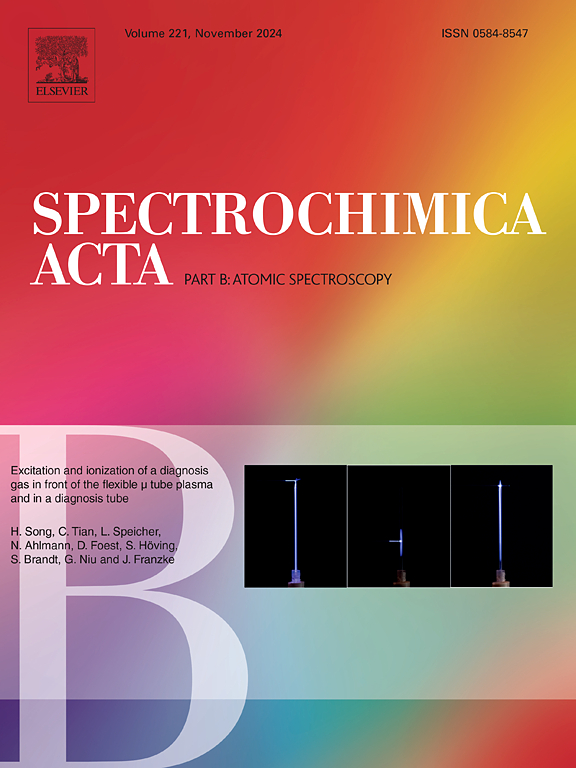利用激光诱导击穿光谱(LIBS)评价玄武岩的化学风化程度及其对火星的意义
IF 3.2
2区 化学
Q1 SPECTROSCOPY
引用次数: 0
摘要
和地球一样,火星也受到化学风化过程的影响。识别火星风化产物和化学风化程度对了解火星的地质历史和气候变化具有重要意义。由“好奇号”、“毅力号”和“朱戎号”等火星车携带的激光诱导击穿光谱(LIBS)在火星表面岩石和土壤的原位表征方面做了出色的工作。该技术具有快速信号采集、遥感能力强、不需要样品制备等优点。在此,我们获取并分析了中国海南岛玄武岩化学风化剖面中收集的一系列风化样品的LIBS光谱,作为火星条件下的火星模拟物。我们从LIBS数据中导出了主要元素浓度(Si, Ti, Al, Fe, Mg, Ca, Na, K),并讨论了风化程度对定量结果的影响。然后,使用传统方法(利用LIBS数据得出的元素丰度)和我们提出的偏最小二乘(PLS)模型(描述风化度指标与LIBS数据之间的关系)计算风化程度。由于PLS模型识别了LIBS数据中潜在的风化信息,因此我们的模型得到的风化程度比传统方法更准确。计算了LIBS数据中元素的相关性和元素随深度的行为,并与XRF结果进行了比较。结果表明,LIBS是评估火星化学风化程度和识别火星化学风化序列的有力工具。本文章由计算机程序翻译,如有差异,请以英文原文为准。

Evaluating chemical weathering degree of basalts using laser-induced breakdown spectroscopy (LIBS) and its implications for Mars
Like Earth, Mars is also modified by chemical weathering processes. It is significant to understand the geological history and climate change of Mars by identifying weathering products and the chemical weathering degree. Laser-induced breakdown spectroscopy (LIBS), carried by rovers such as Curiosity, Perseverance, and Zhurong, has done an excellent job in the in-situ characterization of rocks and soil on the Martian surface. This technique offers advantages such as fast signal acquisition, remote sensing capabilities, and no need for sample preparation. Herein, we acquired and analyzed LIBS spectra from a series of weathered samples collected from a basaltic chemical weathering profile in Hainan Island, China, serving as a Martian analogue, under Martian conditions. We derived the major elemental concentrations (Si, Ti, Al, Fe, Mg, Ca, Na, K) from LIBS data and discussed the influence of weathering degree on quantitative results. Then the weathering degree was calculated using both conventional approaches (utilizing elemental abundance derived from LIBS data) and our proposed partial least squares (PLS) models (which describe the relationship between weathering degree indexes and LIBS data). The weathering degrees derived from our models were more accurate than the traditional approach because our PLS models identified the potential weathering information in LIBS data. The elemental correlation and the behaviors of elements with depth derived from LIBS data were also calculated and compared with the XRF results. Our results showed that LIBS is a powerful tool for evaluating the chemical weathering degree and identifying chemical weathering sequences on Mars.
求助全文
通过发布文献求助,成功后即可免费获取论文全文。
去求助
来源期刊
CiteScore
6.10
自引率
12.10%
发文量
173
审稿时长
81 days
期刊介绍:
Spectrochimica Acta Part B: Atomic Spectroscopy, is intended for the rapid publication of both original work and reviews in the following fields:
Atomic Emission (AES), Atomic Absorption (AAS) and Atomic Fluorescence (AFS) spectroscopy;
Mass Spectrometry (MS) for inorganic analysis covering Spark Source (SS-MS), Inductively Coupled Plasma (ICP-MS), Glow Discharge (GD-MS), and Secondary Ion Mass Spectrometry (SIMS).
Laser induced atomic spectroscopy for inorganic analysis, including non-linear optical laser spectroscopy, covering Laser Enhanced Ionization (LEI), Laser Induced Fluorescence (LIF), Resonance Ionization Spectroscopy (RIS) and Resonance Ionization Mass Spectrometry (RIMS); Laser Induced Breakdown Spectroscopy (LIBS); Cavity Ringdown Spectroscopy (CRDS), Laser Ablation Inductively Coupled Plasma Atomic Emission Spectroscopy (LA-ICP-AES) and Laser Ablation Inductively Coupled Plasma Mass Spectrometry (LA-ICP-MS).
X-ray spectrometry, X-ray Optics and Microanalysis, including X-ray fluorescence spectrometry (XRF) and related techniques, in particular Total-reflection X-ray Fluorescence Spectrometry (TXRF), and Synchrotron Radiation-excited Total reflection XRF (SR-TXRF).
Manuscripts dealing with (i) fundamentals, (ii) methodology development, (iii)instrumentation, and (iv) applications, can be submitted for publication.

 求助内容:
求助内容: 应助结果提醒方式:
应助结果提醒方式:


